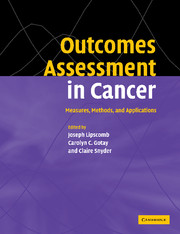Book contents
- Frontmatter
- Contents
- List of contributors
- Acknowledgments
- 1 Introduction to Outcomes Assessment in Cancer
- Health-related quality of life in cancer: general concepts and generic measures
- 2 Definitions and conceptual models of quality of life
- 3 Assessing health status and quality of life of cancer patients: the use of general instruments
- 4 The roles for preference-based measures in support of cancer research and policy
- Assessing health-related quality of life during treatment
- Assessing health-related quality of life across the cancer continuum
- Measuring the experience and needs of cancer patients and caregivers
- Methodological considerations in applications to cancer outcomes research
- Modern psychometric theory in cancer outcomes research
- Assessing the economic impact of cancer
- Research and policy implications
- Invited papers
- Index
- References
3 - Assessing health status and quality of life of cancer patients: the use of general instruments
Published online by Cambridge University Press: 18 December 2009
- Frontmatter
- Contents
- List of contributors
- Acknowledgments
- 1 Introduction to Outcomes Assessment in Cancer
- Health-related quality of life in cancer: general concepts and generic measures
- 2 Definitions and conceptual models of quality of life
- 3 Assessing health status and quality of life of cancer patients: the use of general instruments
- 4 The roles for preference-based measures in support of cancer research and policy
- Assessing health-related quality of life during treatment
- Assessing health-related quality of life across the cancer continuum
- Measuring the experience and needs of cancer patients and caregivers
- Methodological considerations in applications to cancer outcomes research
- Modern psychometric theory in cancer outcomes research
- Assessing the economic impact of cancer
- Research and policy implications
- Invited papers
- Index
- References
Summary
Introduction
In response to the increasing demand for high quality, affordable health care, policy makers are beginning to consider the burden of disease on patients and their families, as well as on society, more generally.– Within the continuum of cancer care, these concerns are often expressed in terms of health promotion and disease prevention initiatives, evaluations of alternative treatments or other interventions, and provision of compassionate care for survivors of cancer or those living with terminal illness. Traditionally, morbidity and mortality measures have been used for assessing disease and policy impacts, but as more people are living longer, many with chronic disease such as cancer, decision makers are recognizing the need for indicators that inform them not only about quantity of life but also about multiple aspects of quality of life such as physical, social, and mental well-being.
Over the past 30 years, instruments have been developed that provide decision makers with profiles of scores that indicate people's capacity or performance on important domains and subdomains of health status and quality of life. Profiles, rather than a battery of single indicators, have the advantage of using a single scoring system so that domain scores can be easily compared, thereby giving clinicians and policy makers systematic information about well-being and function across the key domains. Generic profiles, such as the Sickness Impact Profile– and the short forms from the Medical Outcomes Study,– are used in demographically and diagnostically diverse populations, whereas general cancer measures, e.g., the European Organization for Research and Treatment of Cancer Core Quality of Life Questionnaire (EORTC QLQ-C30) and the Functional Assessment of Cancer Therapy (FACT-G), have been developed for use across the spectrum of cancer diagnoses.
- Type
- Chapter
- Information
- Outcomes Assessment in CancerMeasures, Methods and Applications, pp. 31 - 68Publisher: Cambridge University PressPrint publication year: 2004
References
- 1
- Cited by



